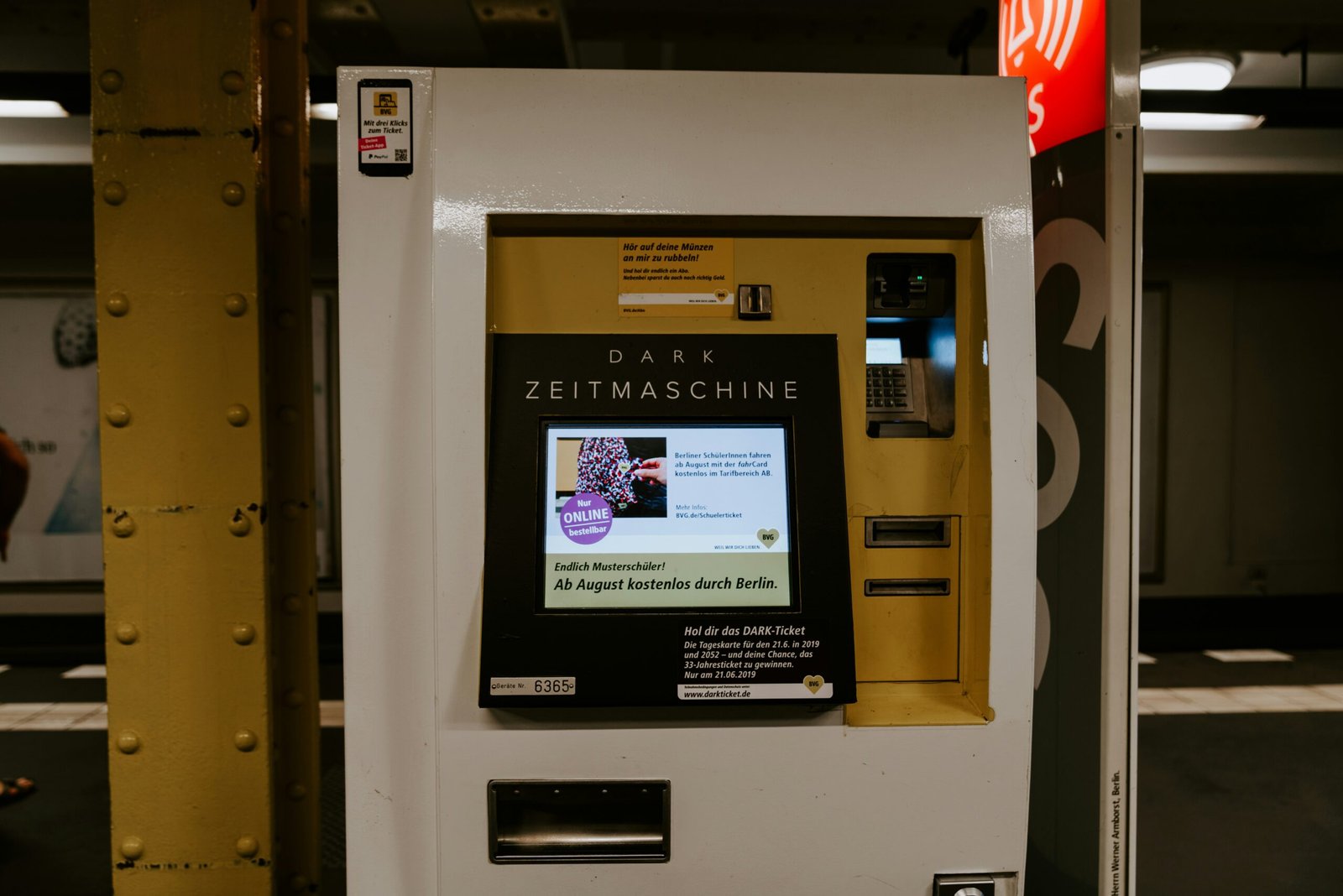Kiosk stands are versatile, self-service stations designed to facilitate various transactions and information dissemination. These stands have become integral in numerous industries, providing a streamlined, efficient way to enhance customer experiences and operational efficiency.
From retail environments to healthcare facilities, kiosk stands serve as pivotal tools in modernizing service delivery. In the retail sector, kiosk stands are commonly used for self-checkout systems, product information displays, and customer service inquiries.
They enable customers to complete transactions quickly and independently, reducing wait times and enhancing overall satisfaction. Retailers benefit from increased efficiency and the ability to allocate human resources to more complex tasks that require personal interaction.
The hospitality industry leverages kiosk stands to optimize guest experiences. Hotels and restaurants use these stands for check-in/check-out processes, reservation management, and promotional displays. By integrating kiosk stands, these establishments can offer a seamless, user-friendly experience that caters to tech-savvy customers and alleviates pressure on staff during peak times.
In the healthcare sector, kiosk stands play a crucial role in patient management and information dissemination. They are used for patient check-ins, appointment scheduling, and accessing medical records. This not only improves patient flow and reduces administrative burdens but also ensures that sensitive information is handled securely and efficiently.
The importance of kiosk stands in today’s market cannot be overstated. They represent a convergence of technology and convenience, catering to the growing demand for self-service options. As industries continue to evolve, the adoption of kiosk stands will likely expand, driving innovation and enhancing service delivery across various sectors.
Planning Your Kiosk Stand
Effective planning is a crucial step in building a successful kiosk stand. The initial phase involves identifying the primary purpose of the kiosk. Whether it is for retail, information dissemination, or food services, a clear understanding of its function will guide all subsequent decisions. This clarity helps in designing a kiosk that meets specific operational requirements and aligns with business objectives.
Understanding the target audience is another fundamental aspect of the planning process. Identifying who will be using the kiosk allows for tailored design and service offerings that cater to their preferences and behaviors. For instance, a kiosk aimed at young adults might feature modern aesthetics and technology integration, while one targeting an older demographic may prioritize accessibility and simplicity.
Location selection is paramount to the success of a kiosk stand. High foot traffic areas such as shopping malls, airports, and public plazas are typically ideal. However, it’s also essential to consider the nature of the surroundings and the competition. Conducting a thorough site analysis can reveal insights into customer flow patterns and peak times, aiding in choosing a location that maximizes visibility and customer engagement.
Budgeting is an integral part of the planning stage. Creating a detailed budget that accounts for construction costs, permits, equipment, and ongoing operational expenses ensures that the project remains financially viable. It’s advisable to include a contingency fund to handle unforeseen costs that may arise during the setup and initial operation phases.
Conducting comprehensive market research is indispensable in the planning process. This research should encompass analyzing competitors, understanding market trends, and identifying potential challenges and opportunities. Insights gained from market research can inform decisions on product offerings, pricing strategies, and promotional tactics, thereby enhancing the kiosk’s ability to meet market demands effectively.
Designing Your Kiosk Stand
When embarking on the journey to build a kiosk stand, the design phase is pivotal. Effective design principles, encompassing aesthetics, functionality, and ergonomics, form the cornerstone of a successful kiosk stand. To create a visually appealing kiosk, one must consider the harmonization of colors, materials, and shapes.
The visual allure of the kiosk should not only attract users but also align with the brand’s identity and message. Functionality is another critical aspect. A kiosk stand must serve its intended purpose efficiently, whether it is for information dissemination, product sale, or customer service. This entails a thoughtful arrangement of components to ensure smooth interaction.
For example, if the kiosk features a touchscreen, it should be positioned at a comfortable height and angle for ease of use. Additionally, accessibility considerations, such as accommodating wheelchair users, are paramount to inclusivity. Ergonomics plays a vital role in the design of a kiosk stand. It ensures that users can interact with the kiosk comfortably and without strain.
This involves considering the height, reach, and overall layout of the kiosk. For instance, the placement of buttons, screens, and other interactive elements should be within easy reach for users of varying heights. An ergonomic design minimizes user fatigue and enhances the overall experience.
Moreover, creating an engaging and user-friendly interface is essential, whether the interaction is digital or physical. If the kiosk features a digital interface, it should be intuitive, responsive, and easy to navigate. A well-designed interface guides users seamlessly through their tasks, providing clear instructions and feedback.
On the other hand, a physical interface should be straightforward, with clearly labeled buttons or touchpoints to facilitate interaction. In summary, the design of a kiosk stand is a multifaceted process that balances aesthetics, functionality, and ergonomics. By focusing on these principles, one can create a kiosk stand that not only meets user needs but also enhances their overall experience.
Material Selection for Kiosk Stands
When constructing a kiosk stand, selecting the appropriate material is a crucial decision that impacts the durability, cost, and overall functionality of the unit. The three primary materials commonly used for kiosk stands are wood, metal, and plastic, each offering distinct advantages and disadvantages.
Wood
is a popular choice for its aesthetic appeal and versatility. Wooden kiosk stands can be customized easily to fit various design preferences, offering a warm and inviting appearance. However, wood is susceptible to damage from moisture and physical wear, making it less suitable for outdoor environments or high-traffic areas. Despite these drawbacks, wood remains a cost-effective option for indoor use, particularly when a bespoke design is desired.
Metal
is favored for its durability and strength, making it ideal for kiosk stands that require a high level of security and robustness. Metals such as steel and aluminum are resistant to wear and environmental factors, which makes them suitable for both indoor and outdoor applications. While metal kiosk stands tend to be more expensive than their wooden counterparts, their longevity and low maintenance requirements often justify the initial investment. Additionally, metal stands can be designed with a sleek, modern aesthetic, appealing to contemporary design sensibilities.
Plastic
particularly high-density polyethylene (HDPE) and acrylic, is another viable option for kiosk stands. Plastic stands are lightweight, resistant to corrosion, and easy to clean, offering practical advantages in environments where hygiene and portability are priorities.
However, plastic may not provide the same level of durability as wood or metal, and its appearance might be less appealing for certain applications. The cost of plastic kiosk stands is generally lower, making them an economical choice for temporary setups or budget-conscious projects.
Ultimately, the choice of material for a kiosk stand should be guided by the specific requirements of the intended use, including the desired durability, aesthetic preferences, and budget constraints. Each material offers unique benefits and trade-offs, and understanding these can help make an informed decision that aligns with the overall objectives of the kiosk project.
Step-by-Step Guide to Building a Kiosk Stand
Building a kiosk stand involves a series of methodical steps, ensuring both functionality and durability. This guide will provide you with a comprehensive approach to constructing a kiosk stand, from framing to the final touches.
1. Planning and Design
Begin by designing your kiosk stand. Sketch out a plan that includes dimensions, materials needed, and placement of components. Consider the purpose of the kiosk and the environment it will be placed in. Ensure the design is ergonomic and accessible.
2. Gathering Materials and Tools
Collect all necessary materials such as plywood, screws, brackets, and paint. Essential tools include a saw, drill, screwdriver, measuring tape, level, and safety gear like gloves and goggles. Having everything on hand will streamline the building process.
3. Constructing the Frame
Cut the plywood according to your design dimensions. Assemble the base frame first, ensuring it is level and stable. Attach the vertical supports and secure them with screws and brackets. Double-check all measurements to ensure accuracy.
4. Assembling Components
Next, attach the panels to the frame, securing them with screws. If your design includes shelves or compartments, install them at this stage. Ensure that all components are firmly in place and that there are no loose parts.
5. Installing Hardware and Software
For kiosks that require electronic components, such as screens or payment systems, carefully install the hardware. Follow manufacturer instructions for each device. Once hardware installation is complete, set up the software and test all functionalities to ensure they operate smoothly.
6. Finishing Touches
After confirming the structural integrity and functionality of your kiosk stand, apply the finishing touches. Sand any rough edges, paint or stain the wood, and add any branding or signage. These elements will enhance the kiosk’s aesthetic and make it more appealing to users.
7. Safety Tips
Throughout the construction process, prioritize safety. Always wear protective gear, keep your workspace clean, and handle tools with care. Ensure that the kiosk stand is stable and can support the weight of all components.
By following these steps, you can build a kiosk stand that is both functional and visually appealing, ready to serve its intended purpose effectively.
Customizing Your Kiosk Stand
Customizing your kiosk stand provides a unique opportunity to enhance user experience and attract customers. Tailoring the design to align with your brand identity is paramount.
Effective branding ensures that your kiosk stand is readily identifiable, helping to create a lasting impression on visitors. This can be achieved through the use of logos, specific color schemes, and thematic elements that reflect your brand’s values and aesthetics.
Color schemes play a crucial role in customization. Selecting colors that are synonymous with your brand can help in reinforcing brand recognition. Additionally, the strategic use of colors can influence customer behavior and perception.
For instance, warm colors such as red and orange can evoke excitement and energy, while cool colors like blue and green can create a sense of calm and trust.
Another significant aspect of customization is the incorporation of additional features such as lighting, seating, and interactive displays. Proper lighting can dramatically improve the visibility and attractiveness of your kiosk stand, especially in dimly lit environments. Accent lighting can highlight specific areas of the kiosk, drawing attention to key displays or products.
Seating arrangements can also enhance the user experience by providing comfort and convenience to customers, encouraging them to spend more time at your kiosk. Whether it’s bar stools, benches, or cushioned seats, the right seating can make a significant difference in customer satisfaction.
Interactive displays are a modern addition that can significantly boost engagement. Touchscreens, digital signage, and interactive kiosks allow customers to interact with your offerings in a dynamic way. This not only provides an engaging experience but also allows for the collection of valuable customer data and feedback.
Incorporating these customization options can transform a standard kiosk stand into a compelling and engaging focal point. By focusing on branding, color schemes, and additional features, businesses can create a kiosk that not only attracts customers but also enhances their overall experience, leading to increased satisfaction and loyalty.
Available Kiosk Stands in the Market
The market for kiosk stands is vast and diverse, catering to various needs, preferences, and budgets. A plethora of kiosk stands are available, each with unique features, benefits, and price points. These can be broadly categorized into two types: ready-made and custom-built kiosks.
Ready-made kiosks are pre-designed and manufactured, offering a quick and often more affordable solution. These kiosks are typically available in standardized sizes and configurations, making them an attractive option for businesses looking for convenience and efficiency.
Common features of ready-made kiosks include touchscreen interfaces, secure enclosures, and integrated payment systems. Popular models, such as the X-Series Kiosk and the Q-Line Kiosk, are known for their robust construction and ease of installation. Prices for ready-made kiosks generally range from $1,000 to $5,000, depending on the complexity and included features.
In contrast, custom-built kiosks are designed to meet specific business requirements. These kiosks offer greater flexibility in terms of design, functionality, and branding.
Businesses can choose from a wide array of materials, finishes, and technological integrations to create a kiosk that aligns perfectly with their needs. While custom-built kiosks typically require a higher initial investment, often starting at $5,000 and going upwards, the tailored solutions they provide can significantly enhance user experience and operational efficiency. Examples of custom-built kiosks include interactive wayfinding systems for large venues and specialized retail kiosks with bespoke software applications.
When comparing ready-made and custom-built kiosks, it is essential to consider the intended use, budget, and timeline. Ready-made kiosks are ideal for businesses seeking quick deployment and cost-effectiveness, while custom-built kiosks are better suited for those requiring specialized features and a unique user experience. Ultimately, the choice between the two depends on the specific needs and strategic goals of the business.
Maintenance and Upkeep of Kiosk Stands
Maintaining kiosk stands is critical to ensure their longevity and optimal performance. Routine cleaning, regular software updates, and systematic troubleshooting are essential components of an effective maintenance strategy for kiosk stands.
Firstly, routine cleaning is paramount. Dust and grime can accumulate on both the exterior and interior components, potentially affecting the kiosk’s functionality.
A simple schedule of weekly cleaning using non-abrasive materials ensures that the touchscreen, keyboard, and other peripherals remain in optimal condition. It is advisable to use specialized cleaning agents designed for electronic devices to avoid damage.
Secondly, software updates are crucial for the security and efficiency of kiosk stands. Manufacturers frequently release updates to fix bugs, enhance features, and improve overall security.
Regularly updating the software helps in safeguarding against potential vulnerabilities and ensures that the kiosk operates smoothly. It is recommended to set up automatic updates if the system allows, or otherwise, schedule periodic manual updates.
Troubleshooting common issues is another vital aspect of kiosk maintenance. Problems such as unresponsive touchscreens, slow performance, or connectivity issues can arise. Having a basic troubleshooting guide can assist in quickly addressing these issues.
For instance, a non-responsive touchscreen might simply require recalibration or a reboot of the system. If the problem persists, consulting the manufacturer’s manual or seeking professional support is advisable.
Regular inspections play a significant role in the upkeep of kiosk stands. Scheduled inspections can help in identifying potential issues before they escalate. These inspections should cover both hardware components and software functionalities, ensuring that all parts are working as intended.
Lastly, professional servicing should not be overlooked. While routine checks and minor repairs can be handled in-house, professional servicing is recommended at least once a year. Professionals can perform comprehensive diagnostics, ensuring that the kiosk stands are in optimal condition and any hidden issues are promptly addressed.



